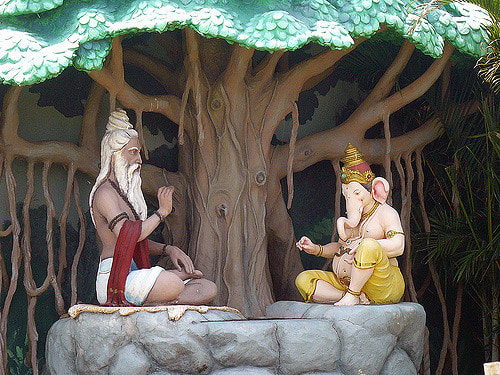
HOW THE EPIC MAHABHARATA WAS WRITTEN
When initially composed Mahabharata was named as ‘JAYA’
नारायणम् नमसकृत्यम् नरमचैव नरोतत्मम्
देवी सरस्वती व्यासम् ततो जय मुदिरेत्
It is the initial shloka in Mahabharata which means – After Namsakara to Nar and Narayan and Godess Saraswati and Vyas, recitation of ‘JAYA’ is to be performed.
Today it has 100000 slokas and is believed to be written by Sage Veda Vyas, but in reality it was narrated by Ved Vyas and written by Lord Ganesha.
When first narrated, it had only 8800 slokas and originally named ‘JAYA’ or (JAYAM) by lord Ganesha.
Vyas’s deciple vaisampayana narrated this story to janamejaya (pariskhit’s son and abhimanyu’s grandson), at takshila, along with additional and elaborated stories, during sarp-yaagam (a yajna that is performed to bring all snakes to extinction by letting them burn to flames as revenge against takshak, a snake, who killed king parikshit).
This made it expand to 24000 slokas and was named ‘VIJAYA’ or (VIJAYAM) and then again renamed as ‘BHARATA’ .
When initially composed Mahabharata was named as ‘JAYA’
नारायणम् नमसकृत्यम् नरमचैव नरोतत्मम्
देवी सरस्वती व्यासम् ततो जय मुदिरेत्
It is the initial shloka in Mahabharata which means – After Namsakara to Nar and Narayan and Godess Saraswati and Vyas, recitation of ‘JAYA’ is to be performed.
Today it has 100000 slokas and is believed to be written by Sage Veda Vyas, but in reality it was narrated by Ved Vyas and written by Lord Ganesha.
When first narrated, it had only 8800 slokas and originally named ‘JAYA’ or (JAYAM) by lord Ganesha.
Vyas’s deciple vaisampayana narrated this story to janamejaya (pariskhit’s son and abhimanyu’s grandson), at takshila, along with additional and elaborated stories, during sarp-yaagam (a yajna that is performed to bring all snakes to extinction by letting them burn to flames as revenge against takshak, a snake, who killed king parikshit).
This made it expand to 24000 slokas and was named ‘VIJAYA’ or (VIJAYAM) and then again renamed as ‘BHARATA’ .

The story is then recited again by a professional story teller (Bard) named ‘Ugrasrava Sauti’ many years later to an assemblage of sages performing the 12-year sacrifice for the king Saunaka kulapati in the naimisa forest .
Ugrasrava belonged to the suta caste, who was typically the bards of ‘Puranic literature’, narrated this story to the sages (Ugrasrava also named as sutamuni or sutagoswami), was the son of sage lomaharshana and belonged to the deciple chain of vyas.
The full 100,000 verses of the Mahabharata was completed several centuries later by addition of many stories such as Bhagwat Gita, story of Nal-Damyanti and story of Sati Savitri and many other stories in it. It was finally named as ‘Mahabharata‘, making it the biggest epic in the world.
Mahabharata means ‘The great Tale of The Bharata Dynasty’
The Mahabharata has been described is the ‘longest known epic poem ever written’ ,about 1.8 million words in total, The Mahabharata is roughly ten times the length of ‘the illiad’ and ‘the odyssey’ combined and about four times the length of ‘The Ramayana’.
Ugrasrava belonged to the suta caste, who was typically the bards of ‘Puranic literature’, narrated this story to the sages (Ugrasrava also named as sutamuni or sutagoswami), was the son of sage lomaharshana and belonged to the deciple chain of vyas.
The full 100,000 verses of the Mahabharata was completed several centuries later by addition of many stories such as Bhagwat Gita, story of Nal-Damyanti and story of Sati Savitri and many other stories in it. It was finally named as ‘Mahabharata‘, making it the biggest epic in the world.
Mahabharata means ‘The great Tale of The Bharata Dynasty’
The Mahabharata has been described is the ‘longest known epic poem ever written’ ,about 1.8 million words in total, The Mahabharata is roughly ten times the length of ‘the illiad’ and ‘the odyssey’ combined and about four times the length of ‘The Ramayana’.

What is a Temple
A temple (from the latin word templum) is a structure reserved for religious or spiritual rituals & activities such as prayer and sacrifice.
The word ‘templum ‘comes from ancient Rome, where a ‘ templum ‘ constituted a sacred precinct (enclosure or boundary line.) as defined by a priest or augur.
What is Meant by the word ‘Mandir’
Mandir is a Sanskrit word which means a ‘Dwelling’
At the heart of the temple(Mandir) rests a shrine to the chosen deity. These shrines contain an image usually a statue or painting of the deity. Each morning the priest adorns the shrine, surrounding the image with fresh flowers, fruits, incense, candles, lamps and other decorations.
Temple pujas are performed at dawn, noon, dusk and midnight. participants take an active role in their worship, beginning with darshan, which simply means “To focus upon a deity” next , the devotees make a food offering. The priest blesses the Prasad or food, which is then consumed by worshippers.
Some temples have room for followers to circle the shrine in a clockwise motion, another popular form of worship.
A mandir is the home of the god worshipped there. The main services at a mandir are at sunrise and sunset.
What are the basic Elements of hindu temple
A hindu temple or Mandir is a structure designed to bring human beings and Gods together using symbolism to express the ideas and beliefs of Hinduism. The symbolism & structure of a hindu temple are rooted in Vedic traditions.
A Hindu Temple incorporates all elements of Hindu cosmos – representing the good, the evil and the human, as well as the elements of hindu sense of cyclic time & the essence of life – symbolically presenting dharma, karma, artha, moksha and kama.
What is the structure of a Hindu temple
In ancient times there was only a verandah on which idols were constructed , there was no structure constructed on top of that
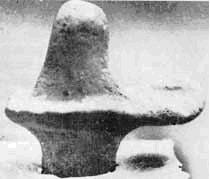
A Shivalinga on open verandah found in excavation of mohenjo-daro
Tell about the beginning and purpose of temples
From the 1st century a new type of worship known as “Bhakti” or devotional Hiduism spread across the Indian sub-continent and the old vedic gods (nature gods such as Sun, Moon etc) were replaced in temples by deities such as Shiva, Vishnu, Krishna, Brahma and devi’s. These Gods would become the central figures of Hinduism and their worship required temples where the devotees could offer their thanks and reveal their hopes for a better life. And this hope keeps us alive and increases the importance of the temple..
When idol Worship became famous
The earliest temple structure was found in Surkh Kotal, a place in Afghanistan in the year 1951 by a French archeologist.
The temple was dedicated to king kanishka of 121 – 151 AD, eventually the importance of idol worship started to gain importance towards the end of the vedic period and thus the concept of temples for gods came into light.
When construction of Temples started
In fact the earliest structures that indicate idol worship can be traced back to 4th or the 5th century AD. There was significant growth and rise of the Hindu temples between the 6th and 16th century and a great part of it can be contributed to the various dynasties that ruled India during that period. They considered that building temples was an extremely pious act and hence kings, wealthy men were ready to put their hands down and help in the building of the temples for its growth and perform various religious activities.
What is hindu Temple Architecture
The Hindu temple architecture is an open, symmetry driven structure, with many variations, on a square grid of padas, depicting perfect geometric shapes such as circles and squares
Example - Angkor Wat, a World Heritage Site and one of the world's largest Hindu temples.This Cambodian temple deploys the same circles and squares grid architecture as described in ancient Indian Vastu Sastras.
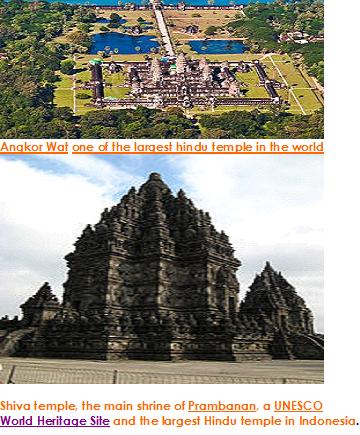
In ancient Indian texts, a temple is a place for Tirtha - pilgrimage. It is a sacred site whose ambience and design attempts to symbolically condense the ideal tenets of Hindu way of life. All the cosmic elements that create and celebrate life in Hindu pantheon, are present in a Hindu temple - from fire to water, from images of nature to deities, from the feminine to the masculine, from kama to artha, from the fleeting sounds and incense smells to Purusha - the eternal nothingness yet universality - is part of a Hindu temple architecture
The architectural principles of Hindu temples in India are described in Shilpa Shastras and Vastu Sastras.
The underlying principle in a Hindu temple is built around the belief that all things are one, everything is connected. The pilgrim is welcomed through mathematically structured spaces, a network of art, pillars with carvings and statues that display and celebrate the four important and necessary principles of human life - the pursuit of artha (prosperity, wealth), the pursuit of kama (desire), the pursuit of dharma (virtues, ethical life) and the pursuit of moksha (release, self-knowledge).
At the center of the temple, typically below and sometimes above or next to the deity, is mere hollow space with no decoration, symbolically representing Purusa, the Supreme Principle, the sacred Universal, one without form, which is present everywhere, connects everything, and is the essence of everyone. A Hindu temple is meant to encourage reflection, facilitate purification of one’s mind, and trigger the process of inner realization within the devotee. The specific process is left to the devotee’s school of belief
The architectural principles of Hindu temples in India are described in Shilpa Shastras and Vastu Sastras.
The underlying principle in a Hindu temple is built around the belief that all things are one, everything is connected. The pilgrim is welcomed through mathematically structured spaces, a network of art, pillars with carvings and statues that display and celebrate the four important and necessary principles of human life - the pursuit of artha (prosperity, wealth), the pursuit of kama (desire), the pursuit of dharma (virtues, ethical life) and the pursuit of moksha (release, self-knowledge).
At the center of the temple, typically below and sometimes above or next to the deity, is mere hollow space with no decoration, symbolically representing Purusa, the Supreme Principle, the sacred Universal, one without form, which is present everywhere, connects everything, and is the essence of everyone. A Hindu temple is meant to encourage reflection, facilitate purification of one’s mind, and trigger the process of inner realization within the devotee. The specific process is left to the devotee’s school of belief
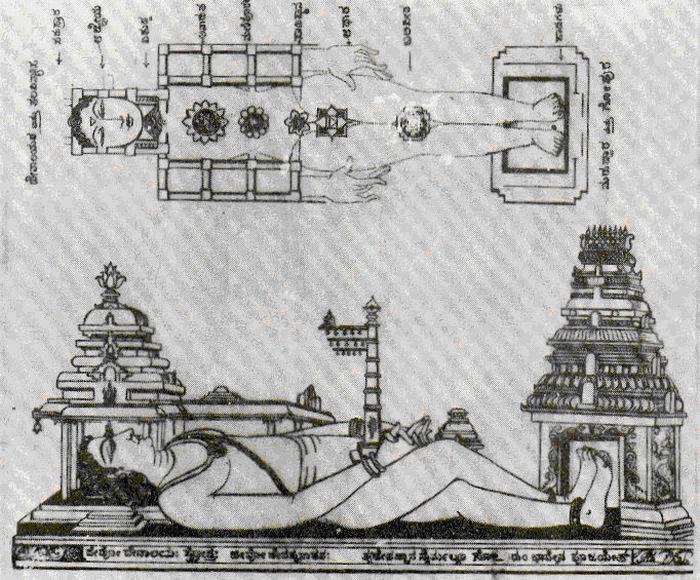
A Vedic Hindu temple’s architecture is a divine and yogic representation of a human being as shown in the figure . The feet represent the spire (rajagopuram). The hands represent the walkway (prakaaram) encompassing all around the temple. The main hall (mandapam) represents the abdomen.
The entrance porch (antaraalam) represents the heart. The sanctum sanctorum (garbha griha) represents the head. The deity is consecrated with religious rites in the sanctum sanctorum. There is proportionality between the size of the deity in the sanctum sanctorum and the sizes of the temple construction details.
The site
The appropriate site for a Mandir, suggest ancient Sanskrit texts, is near water and gardens, where lotus and flowers bloom, where swans, ducks and other birds are heard, where animals rest without fear of injury or harm. These harmonious places were recommended in these texts with the explanation that such are the places where gods play, and thus the best site for Hindu temples.
While major Hindu Mandirs are recommended at sangams (confluence of rivers), river banks, lakes and seashore, Brhat Samhita and Puranas suggest temples may also be built where a natural source of water is not present. Here too, they recommend that a pond be built preferably in front or to the left of the temple with water gardens. If water is neither present naturally nor by design, water is symbolically present at the consecration of temple or the deity. Temples may also be built, suggests Visnudharmottara in Part III of Chapter 93, inside caves and carved stones, on hill tops affording peaceful views, mountain slopes overlooking beautiful valleys, inside forests and hermitages, next to gardens, or at the head of a town street.
The layout
A Hindu temple design follows a geometrical design called vastu-purusha-mandala. The name is a composite Sanskrit word with three of the most important components of the plan. Mandala means circle, Purusha is universal essence at the core of Hindu tradition, while Vastu means the dwelling structure.Vastupurushamandala is a yantra.The design lays out a Hindu temple in a symmetrical, self-repeating structure derived from central beliefs, myths, cardinality and mathematical principles.
The entrance porch (antaraalam) represents the heart. The sanctum sanctorum (garbha griha) represents the head. The deity is consecrated with religious rites in the sanctum sanctorum. There is proportionality between the size of the deity in the sanctum sanctorum and the sizes of the temple construction details.
The site
The appropriate site for a Mandir, suggest ancient Sanskrit texts, is near water and gardens, where lotus and flowers bloom, where swans, ducks and other birds are heard, where animals rest without fear of injury or harm. These harmonious places were recommended in these texts with the explanation that such are the places where gods play, and thus the best site for Hindu temples.
While major Hindu Mandirs are recommended at sangams (confluence of rivers), river banks, lakes and seashore, Brhat Samhita and Puranas suggest temples may also be built where a natural source of water is not present. Here too, they recommend that a pond be built preferably in front or to the left of the temple with water gardens. If water is neither present naturally nor by design, water is symbolically present at the consecration of temple or the deity. Temples may also be built, suggests Visnudharmottara in Part III of Chapter 93, inside caves and carved stones, on hill tops affording peaceful views, mountain slopes overlooking beautiful valleys, inside forests and hermitages, next to gardens, or at the head of a town street.
The layout
A Hindu temple design follows a geometrical design called vastu-purusha-mandala. The name is a composite Sanskrit word with three of the most important components of the plan. Mandala means circle, Purusha is universal essence at the core of Hindu tradition, while Vastu means the dwelling structure.Vastupurushamandala is a yantra.The design lays out a Hindu temple in a symmetrical, self-repeating structure derived from central beliefs, myths, cardinality and mathematical principles.
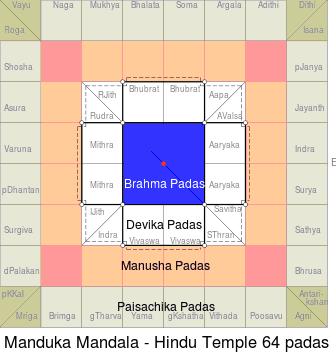
The four cardinal directions help create the axis of a Hindu temple, around which is formed a perfect square in the space available. The circle of mandala circumscribes the square. The square is considered divine for its perfection and as a symbolic product of knowledge and human thought, while circle is considered earthly, human and observed in everyday life (moon, sun, horizon, water drop, rainbow). Each supports the other
The square is divided into perfect square grids. In large temples, this is often a 8x8 or 64 grid structure. In ceremonial temple superstructures, this is an 81 sub-square grid. The squares are called ‘‘padas’’. The square is symbolic and has Vedic origins from fire altar, Agni. The alignment along cardinal direction, similarly is an extension of Vedic rituals of three fires. This symbolism is also found among Greek and other ancient civilizations, through the gnomon.
The central square(s) of the 64 is dedicated to the Brahman (not to be confused with Brahmin), and are called Brahma padas.
The outermost layer, Paisachika padas, signify aspects of Asuras and evil; the next inner concentric layer is Manusha padas signifying human life; while Devika padas signify aspects of Devas and good. The Manusha padas typically houses the ambulatory. The devotees, as they walk around in clockwise fashion through this ambulatory to complete Parikrama (or Pradakshina), walk between good on inner side and evil on the outer side.
The square is divided into perfect square grids. In large temples, this is often a 8x8 or 64 grid structure. In ceremonial temple superstructures, this is an 81 sub-square grid. The squares are called ‘‘padas’’. The square is symbolic and has Vedic origins from fire altar, Agni. The alignment along cardinal direction, similarly is an extension of Vedic rituals of three fires. This symbolism is also found among Greek and other ancient civilizations, through the gnomon.
The central square(s) of the 64 is dedicated to the Brahman (not to be confused with Brahmin), and are called Brahma padas.
The outermost layer, Paisachika padas, signify aspects of Asuras and evil; the next inner concentric layer is Manusha padas signifying human life; while Devika padas signify aspects of Devas and good. The Manusha padas typically houses the ambulatory. The devotees, as they walk around in clockwise fashion through this ambulatory to complete Parikrama (or Pradakshina), walk between good on inner side and evil on the outer side.
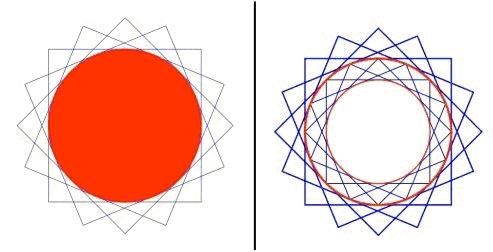
The Paisachika padas, Manusha padas and Devika padas surround Brahma padas, which signifies creative energy and serves as the location for temple’s primary idol for darsana. Finally at the very center of Brahma padas is Garbhagruha(Garbha- Centre, gruha- house; literally the center of the house) (Purusa Space), signifying Universal Principle present in everything and everyone. The spire of a Hindu temple, called Shikhara in north India and Vimana in south India, is perfectly aligned above the Brahma pada(s).
Which are the most Famous and Mysterious Temples of India and the Stories Associated with them visit - -
STORIES RELATED TO INDIAN TEMPLES SECTION
Which are the most Famous and Mysterious Temples of India and the Stories Associated with them visit - -
STORIES RELATED TO INDIAN TEMPLES SECTION
